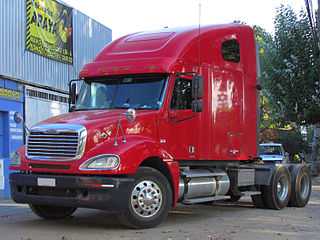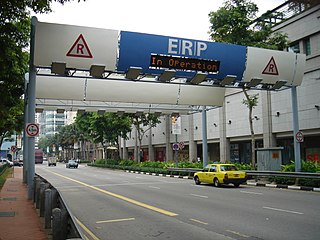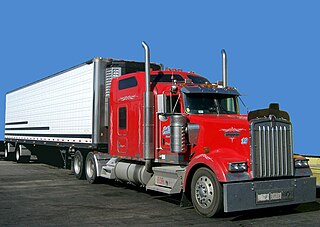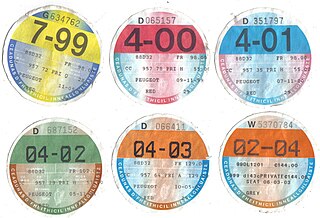
A semi-trailer truck, also known as a semitruck, is the combination of a tractor unit and one or more semi-trailers to carry freight. A semi-trailer attaches to the tractor with a type of hitch called a fifth-wheel.

A toll road, also known as a turnpike or tollway, is a public or private road for which a fee is assessed for passage. It is a form of road pricing typically implemented to help recoup the costs of road construction and maintenance.

The Singapore Area Licensing Scheme (ALS), was a road pricing scheme introduced in 1975 to 1998, charged drivers who were entering downtown Singapore, and thereby aimed to manage traffic demand. This was the first urban traffic congestion pricing scheme to be successfully implemented in the world. This scheme affected all roads entering a 6-square-kilometre area in the Central Business District (CBD) called the "Restricted Zone" (RZ), later increased to 7.25 square kilometres to include areas that later became commercial in nature. The scheme was replaced in 1998 by the Electronic Road Pricing.

Electronic toll collection (ETC) is a wireless system to automatically collect the usage fee or toll charged to vehicles using toll roads, HOV lanes, toll bridges, and toll tunnels. It is a faster alternative which is replacing toll booths, where vehicles must stop and the driver manually pays the toll with cash or a card. In most systems, vehicles using the system are equipped with an automated radio transponder device. When the vehicle passes a roadside toll reader device, a radio signal from the reader triggers the transponder, which transmits back an identifying number which registers the vehicle's use of the road, and an electronic payment system charges the user the toll. A major advantage is the driver does not have to stop, reducing traffic delays. Electronic tolling is cheaper than a staffed toll booth, reducing transaction costs for government or private road owners. The ease of varying the amount of the toll makes it easy to implement road congestion pricing, including for high-occupancy lanes, toll lanes that bypass congestion, and city-wide congestion charges. The payment system usually requires users to sign up in advance and load money into a declining-balance account, which is debited each time they pass a toll point.

The Electronic Road Pricing (ERP) system is an electronic toll collection scheme adopted in Singapore to manage traffic by way of road pricing, and as a usage-based taxation mechanism to complement the purchase-based Certificate of Entitlement system.
Vehicle Excise Duty (VED) is an annual tax that is levied as an excise duty and which must be paid for most types of powered vehicles which are to be used on public roads in the United Kingdom. Registered vehicles that are not being used or parked on public roads and which have been taxed since 31 January 1998, must be covered by a Statutory Off Road Notification (SORN) to avoid VED. In 2016, VED generated approximately £6 billion for the Exchequer.

A large goods vehicle (LGV), or heavy goods vehicle (HGV), in the European Union (EU) is any truck with a gross combination mass (GCM) of over 3,500 kg (7,716 lb). Sub-category N2 is used for vehicles between 3,500 kg and 12,000 kg (26,455 lb) and N3 for all goods vehicles over 12,000 kg as defined in Directive 2001/116/EC. The term medium goods vehicle is used within parts of the UK government to refer to goods vehicles of between 3,500 and 7,500 kg which according to the EU are also "large goods vehicles".

A commercial driver's license (CDL) is a driver's license required to operate large, heavy, or placarded hazardous material vehicles in commerce, including trucks, buses, and trailers.
Vignette is a form of road pricing imposed on vehicles, usually in addition to the compulsory road tax, based on a period of time the vehicle may use the road, instead of road tolls that are based on distance travelled. Vignettes are currently used in several European countries. The term originated in France in the 1950s, although vignettes there were not linked to motorway use and no longer exist; it is now used throughout Central Europe, as well as in Italy (vignetta).

Telepass is the brand name for an electronic toll collection system used to collect toll (pedaggio) on motorways (autostrade) in Italy operated by Autostrade per l'Italia S.p.A., its affiliates, and other legal entities. The system was introduced in 1989.
A toll road is a road over which users may travel over on payment of a toll, or fee. Tolls are a form of use tax that pays for the cost of road construction and maintenance, without raising taxes on non-users. Investor's bonds necessary for the construction of the roads are issued and sold with the expectation that the bonds will be paid back with user tolls. The toll roads may be run by government agencies that have bond issuing authority and/or private companies that sell bonds or have other sources of finance. Toll roads are usually a government guaranteed road monopoly that guarantees limited or no competing roads will be built by government agencies for the duration of the bonds. Private toll roads built with money raised from private investors in expectation of making money from the tolls probably dominated early toll roads. Government sponsored toll roads often guarantee a minimum payment to the bond holders if traffic volume and toll collections are less than predicted. If the toll authority is a private company there is often a maximum amount of fees that they may extract from users. Toll road operators are typically responsible for maintaining the roads. After the bonds are paid off the road typically reverts to the government agency that authorized the road and owns the land it was built on. Like most government taxes it is not unusual for tolls to continue to be charged after the bonds have been paid off.

Video tolling is a form of electronic toll collection, which uses video or still images of a vehicle's license plate to identify a vehicle liable to pay a road toll. The system dispenses with collection of road tolls using road-side cash or payment card methods, and may be used in conjunction with "all electronic" open road tolling, to permit drivers without an RFID device to use the toll road.

e-TAG is a free-flow tolling electronic toll collection system used on all tollways throughout Australia. It was originally developed by Transurban for use on their CityLink tollway in the late 1990s, with the system since adopted by all toll roads, bridges and tunnels in Australia. The technology had different names depending on the issuer, such as Breeze, Linkt, and E-toll. However, these are all interchangeable across Australia and no surcharges apply for use on other operators' toll roads.

The HGV toll is the tolling scheme for heavy goods vehicles traversing German motorways. Charges are based on the distance driven in kilometres, the emission category of the vehicle and the number of axles.

Motor Tax is an annual duty payable on motor vehicles in Ireland for use in public places. A new system for new private cars was introduced on 1 July 2008 where the tax rates are based on the carbon dioxide emissions of the car while in operation. Prior to this, tax rates are assessed on engine displacement - this includes used imports first registered in their original country of sale before July 2008. Motorcycles are all taxed the same regardless of engine displacement, with a special rate for electrically powered cycles. For goods vehicles, commercial vehicles and PSVs it is based on weight or is a standardised fee. For taxation of cars with Wankel engines under the old size-based system, the actual engine displacement is multiplied by 1.5 so for example a Mazda RX-8 with a 1.3 litre rotary engine is taxed as a 1.8 litre engined vehicle.
eToll is a National Roads Authority run interoperability system allowing cashless payment on all of Ireland's toll roads. Based on an RFID tag attached to the windscreen of a participating vehicle, it allows drivers to travel on the tolled sections of them M1, M4, M6, M7, M8 and M50 as well as the East Link, N25 Waterford bypass, Dublin Port Tunnel, and the Limerick (Shannon) Tunnel.
GNSS road pricing or GNSS-based tolling is the charging of road users using Global Navigation Satellite System (GNSS) sensors inside vehicles. Road pricing using GNSS simplifies distance-based tolling for any or all types of roads in a tolled road network since it does not require the installation and operation of roadside infrastructure, such as toll booths or microwave-based toll gantries. Instead, all vehicles required to pay the distance-based fees are equipped with an On Board Unit (OBU), in Singapore also known as an "In-vehicle Unit" (IU). GNSS-based electronic tolling solutions are used to charge trucks above 3.5 tons for road usage on the entire national road network in European countries such as Germany, Slovakia, Hungary, Belgium, Russia, the Czech Republic, and in Bulgaria. Like the Czech Republic, Poland plans to replace its microwave-based tolling system with a GNSS-based solution in 2021. Satellite-based technology can generate greater toll revenue and eliminate the problem of congestion caused by traffic diversion when vehicles subject to tolls are no longer motivated to drive on alternative routes in order to avoid the distance-based fees, since all roads can be easily tolled without the need for installing otherwise costly roadside infrastructure. Once installed, the GNSS-based road pricing solution can also be used for other applications such as in parking and insurance. After the introduction of the first GNSS-based tolling systems in Europe, some critics argued that this approach could lead to an invasion of people’s privacy. However, the European Union's General Data Protection Regulation (EU) 2016/679 (GDPR) applies since 25 May 2018.
A vehicle category classifies a land vehicle or trailer for regulatory purposes.
The multi-lane free flow(MLFF) is a system that allows free-flow high-speed tolling for all highway users. With MLFF, current toll lanes at toll plazas can be replaced with ordinary multilane road segments. By using tags with readers at gantry across the highway to detect vehicle and deduct toll using the existing Electronic Toll Collection (ETC) when fully implemented. Using only video and automatic license plate recognition it is also possible to have a MLFF system without using tags and readers. This type of solution is implemented in Stockholm for congestion charging purposes.
In Slovakia, taxes are levied by the state and local governments. Tax revenue stood at 18.732% of the country's gross domestic product in 2019. The tax-to-GDP ratio in the Slovakia increased by 0.4 percentage points from 34.3% in 2018 to 34.7% in 2019. The most important revenue sources for the state government are income tax, social security, value-added tax and corporate tax.











